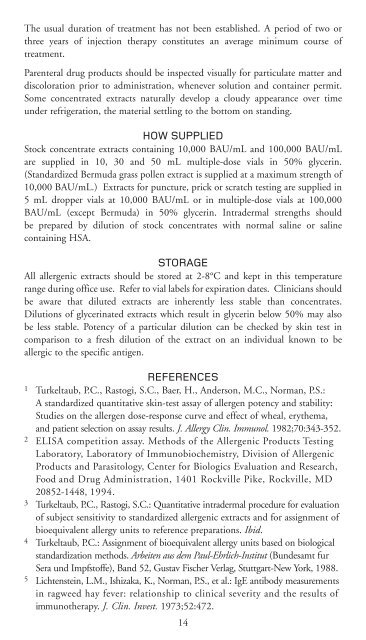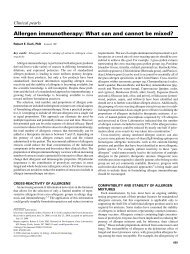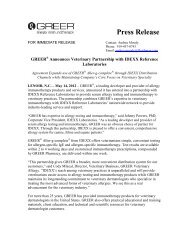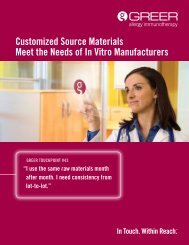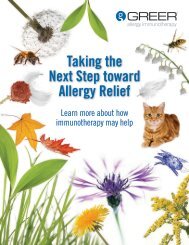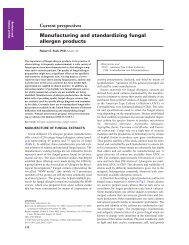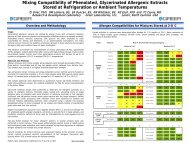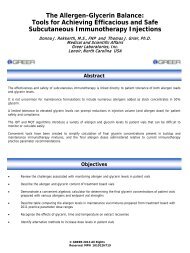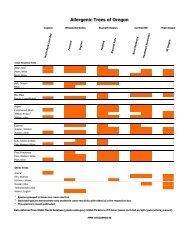Human Allergy Catalog - Greer
Human Allergy Catalog - Greer
Human Allergy Catalog - Greer
You also want an ePaper? Increase the reach of your titles
YUMPU automatically turns print PDFs into web optimized ePapers that Google loves.
The usual duration of treatment has not been established. A period of two orthree years of injection therapy constitutes an average minimum course oftreatment.Parenteral drug products should be inspected visually for particulate matter anddiscoloration prior to administration, whenever solution and container permit.Some concentrated extracts naturally develop a cloudy appearance over timeunder refrigeration, the material settling to the bottom on standing.HOW SUPPLIEDStock concentrate extracts containing 10,000 BAU/mL and 100,000 BAU/mLare supplied in 10, 30 and 50 mL multiple-dose vials in 50% glycerin.(Standardized Bermuda grass pollen extract is supplied at a maximum strength of10,000 BAU/mL.) Extracts for puncture, prick or scratch testing are supplied in5 mL dropper vials at 10,000 BAU/mL or in multiple-dose vials at 100,000BAU/mL (except Bermuda) in 50% glycerin. Intradermal strengths shouldbe prepared by dilution of stock concentrates with normal saline or salinecontaining HSA.STORAGEAll allergenic extracts should be stored at 2-8°C and kept in this temperaturerange during office use. Refer to vial labels for expiration dates. Clinicians shouldbe aware that diluted extracts are inherently less stable than concentrates.Dilutions of glycerinated extracts which result in glycerin below 50% may alsobe less stable. Potency of a particular dilution can be checked by skin test incomparison to a fresh dilution of the extract on an individual known to beallergic to the specific antigen.REFERENCES1 Turkeltaub, P.C., Rastogi, S.C., Baer, H., Anderson, M.C., Norman, P.S.:A standardized quantitative skin-test assay of allergen potency and stability:Studies on the allergen dose-response curve and effect of wheal, erythema,and patient selection on assay results. J. <strong>Allergy</strong> Clin. Immunol. 1982;70:343-352.2 ELISA competition assay. Methods of the Allergenic Products TestingLaboratory, Laboratory of Immunobiochemistry, Division of AllergenicProducts and Parasitology, Center for Biologics Evaluation and Research,Food and Drug Administration, 1401 Rockville Pike, Rockville, MD20852-1448, 1994.3 Turkeltaub, P.C., Rastogi, S.C.: Quantitative intradermal procedure for evaluationof subject sensitivity to standardized allergenic extracts and for assignment ofbioequivalent allergy units to reference preparations. Ibid.4 Turkeltaub, P.C.: Assignment of bioequivalent allergy units based on biologicalstandardization methods. Arbeiten aus dem Paul-Ehrlich-Institut (Bundesamt furSera und Impfstoffe), Band 52, Gustav Fischer Verlag, Stuttgart-New York, 1988.5 Lichtenstein, L.M., Ishizaka, K., Norman, P.S., et al.: IgE antibody measurementsin ragweed hay fever: relationship to clinical severity and the results ofimmunotherapy. J. Clin. Invest. 1973;52:472.14


